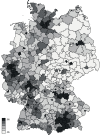Sources of individual differences in adults' ICT skills: A large-scale empirical test of a new guiding framework
- PMID: 33872320
- PMCID: PMC8054998
- DOI: 10.1371/journal.pone.0249574
Sources of individual differences in adults' ICT skills: A large-scale empirical test of a new guiding framework
Abstract
We develop an integrative conceptual framework that seeks to explain individual differences in the ability to use information and communication technologies (ICT skills). Building on practice engagement theory, this framework views the continued usage of digital technologies at work and in everyday life (ICT use) as the key prerequisite for the acquisition of ICT skills. At the same time, the framework highlights that ICT use is itself contingent upon individual and contextual preconditions. We apply this framework to data from two recent German large-scale studies (N = 2,495 and N = 2,786, respectively) that offer objective measures of adults' ICT skills. Findings support our framework's view of ICT use as a key prerequisite for ICT skills. Moreover, they demonstrate that literacy skills have strong associations with ICT skills, largely by virtue of their indirect associations through ICT use. By comparison, regional digital cultures (as proxied by internet domain registration rates) evince only limited explanatory power for individual differences in ICT skills.
Conflict of interest statement
The authors have declared that no competing interests exist.
Figures




References
-
- International ICT Literacy Panel. Digital Transformation: A Framework for ICT Literacy. A Report of the International ICT Literacy Panel. [Internet]. Princeton, NJ: Educational Testing Service (ETS); 2007 [cited 2018 Apr 10]. Available from: https://www.ets.org/Media/Tests/Information_and_Communication_Technology...
-
- European Commission. Monitoring the Digital Economy & Society 2016–2021 [Internet]. 2015 [cited 2018 Jul 2]. Available from: http://ec.europa.eu/eurostat/documents/341889/725524/Monitoring+the+Digi...
-
- Falck O, Heimisch A, Wiederhold S. Returns to ICT Skills [Internet]. Paris, FR: OECD Publishing; 2016 [cited 2018 Apr 10]. [OECD Education Working Papers]. Report No.: 134. Available from: 10.1787/5jlzfl2p5rzq-en - DOI
-
- Felstead A, Gallie D, Green F, Zhou Y. Skills at Work, 1986 to 2006. Cardiff, UK: ESRC Research Centre on Skills, Knowledge and Organizational Performance; 2007.
-
- Reder S. The Development of Literacy and Numeracy in Adult Life. In: Reder S, Bynner J, editors. Tracking Adult Literacy and Numeracy Skills: Findings from Longitudinal Research. New York: Routledge; 2009. p. 59–84.
Publication types
MeSH terms
LinkOut - more resources
Full Text Sources
Other Literature Sources

